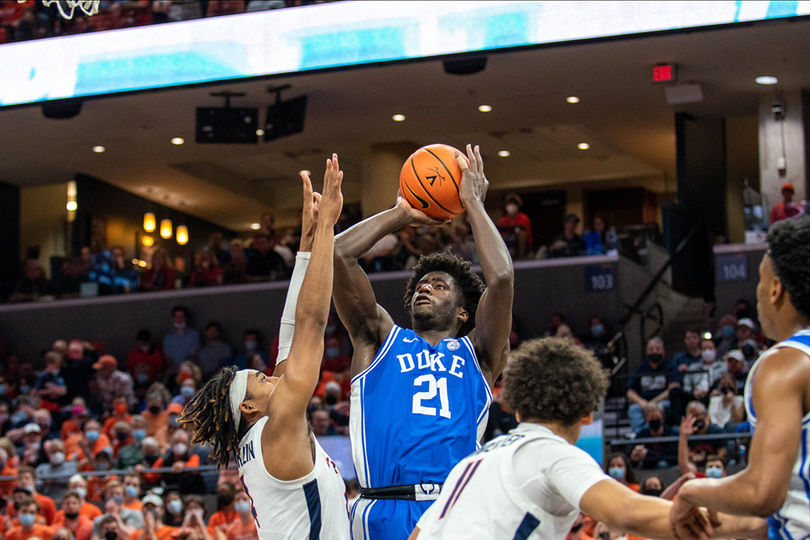‘Some kids have the gene’: AJ Griffin’s ascent to Duke’s latest lottery prospect

AJ Griffin hit several clutch shots down the stretch in his latest game against Virginia. Courtesy of Simran Prakash | The Chronicle
Get the latest Syracuse news delivered right to your inbox.
Subscribe to our sports newsletter here.
In a matter of two minutes, AJ Griffin had already settled into a rhythm. Duke’s first possession ended with him perched on the left side with almost three steps of space between him and an out-of-position SU defender. His shot sank through the net.
And on the next possession, the same thing happened. It was only Griffin’s fourth game starting for the Blue Devils, temporarily abandoning the sixth-man role he’d carved out as a freshman, and the Orange collapsed too hard on Paolo Banchero in the middle, leaving Griffin free again with lots of space on the right side. Banchero tossed the ball over Joe Girard III’s hands, and Griffin set his right foot into his wide shooting stroke and drained the 3-pointer.
Griffin’s offensive presence, as well as his defensive skill set that was sharpened throughout high school and New York-based PSA Cardinals AAU team, has made him indispensable to Duke’s lineup. The five-star freshman has started the Blue Devils’ last 13 games entering Saturday’s contest against Syracuse in the Carrier Dome, averaging 9.9 points per game, 3.6 rebounds and avoiding another injury scare — like he had in the fall and dating back to high school — that could limit his minutes, too.
“Some kids have the gene,” said Mark Carter, Griffin’s coach at PSA, “and I think AJ is one of those kids who has the gene.”
When Carter first met Griffin, he was out recruiting Alan Griffin, AJ’s older brother who played at Syracuse last season. AJ was 6-foot-2 as an eighth grader, and Carter recalled Alan telling him that, “I can hoop, but my brother, he’s next.” Carter said that stuck with him through the years he coached AJ and watched him develop. It stuck with him throughout this past season, when Duke’s winning streak that followed a loss to Ohio State coincided with AJ’s minutes and role expanding.
PSA only practiced on the weekends, conducting “intense” double sessions both days that featured 20-minute segments of conditioning built in at the start. Packed into those workouts were full-court wheelbarrow crawls, guerrillas where players hopped around and touched the floor and crab walks or sprints where someone had to carry a teammate back and forth from end-line to end-line.
The team wanted to reinvent what would typically be found in a conditioning drill, and then watch as that translated over to the court during games, Carter said. PSA was a defensive-focused program because it’s the most common aspect that players had trouble adjusting to, and Griffin slid right into Carter’s focus on becoming an offensive guy who can also carry their own weight on defense — learning how to defend a pick and roll and how to defend the mismatches. PSA didn’t switch on screens, Carter said, so Griffin practiced making himself skinny to avoid getting caught away from the player he was defending.
As he progressed through PSA, eventually starting high school basketball at Archbishop Stepinac High School and starring there, he received an invitation to try out for the Team USA U16 team at the 2019 International Basketball Federation Americas Championship. With Team USA, Griffin learned to adapt when every play wasn’t drawn up for him. They had a roster full of future college and professional players, said then-head coach Mike Jones, and Griffin learned that he couldn’t shoot when he wanted to and “how to play with four other really good players.”

Maya Goosmann | Digital Design Director
When Team USA opened the tournament in danger of losing its first-ever game at the U16 level, Griffin grabbed the ball, raced up the court, weaved through Argentinian players and dunked over them. “Literally the whole game changed,” Jones said. Sharman White, an assistant coach on that year’s team, said they tried to isolate Griffin at times with ball screens, placing him in positions to convert baskets.
“He can play outside, but he would beat you off the dribble,” Carter said. “And he’s nimble in that sense where he’s not a kid who’s going to get in there out of control.”
But sprinkled in throughout that gold-medal tournament, and the rise in high school as a five-star prospect, were the knee injuries. They caused him to miss games and eventually parts of seasons. It became the red flag, the one mark for someone with the potential to enter college and immediately start at Duke. That echoed a bit louder when he reinjured that knee in the fall, but he recovered in time for the bulk of this season.
“Once he was able to get healthy, we saw what it’s turned out to be down in Durham,” Carter said.
Before that injury happened, Carter sent Griffin a text in the final week of August, after he’d arrived at Duke for the fall semester. He always texted him that week — they shared the same Aug. 23 birthday, and Carter always called him “twin.” This year, like most year’s versions, Carter typed, “Happy birthday twin. Keep pushing. God always has your back. And the sky’s the limit.”
Because in Carter’s eyes, that was the case for Griffin. He just hadn’t had the window to manifest it yet at the college level. And slowly, over the course of the next six months — injury flare-up and all — that envisioned reality has started to materialize.





